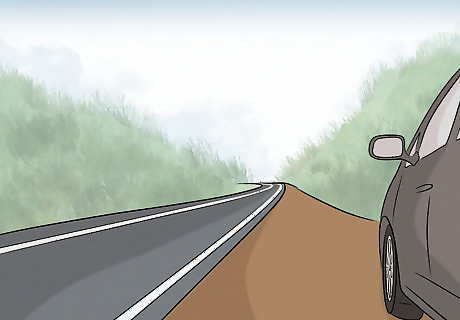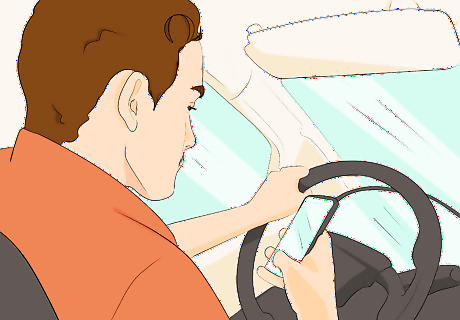
views
X
Research source
Read on to learn about the effects of road rage and how you can keep it from taking over.
- Road rage invokes a fight-or-flight response that can lead to tunnel vision, causing you to miss important details on the roadway.
- Drivers under the effect of road rage make sudden, aggressive, and unpredictable movements that can lead to serious accidents.
- Avoid road rage by giving yourself plenty of time to reach your destination and not taking the actions of other drivers personally.
The Impact of Road Rage on Driving and Judgement

Fight-or-flight response Road rage is a response to stress, which triggers your body's fight-or-flight response. Since you're likely unable to flee (especially if you're stuck in traffic), the "fight" portion of the response kicks in. Your heart rate increases and your breathing becomes shallow. Adrenaline pumps into your bloodstream, your muscles tense up, and you're ready to pounce. When you're in this state of mind, you're on high alert. Your senses are heightened, which seems like it would be a good thing while driving. But your focus is no longer on driving—it's on whoever enraged you.

Rude or offensive behavior When you become enraged, you might shout or curse at other drivers—even if they can't hear you. They can see you, though, and if you're in a road rage you're likely to shake your head, make faces, or throw up rude gestures so other drivers know you're angry.

Tunnel vision In a full-blown road rage, you lose sight of everything and everyone around you save the one driver that triggered your anger. You're going to go after them no matter what, whether to "teach them a lesson" or get back at them in some way. This tunnel vision means that you might not notice a car or other obstacle that gets in your way until it's too late to react, which could lead to an accident.

Impaired judgment Under the effects of road rage, you're not thinking clearly at all. Anything seems worth it to get out of the situation that you're in—or to get back at the target of your rage. For example, if someone cuts you off, you might think nothing of speeding up and blowing past other drivers to go after them so you can cut them off yourself.

Risky and aggressive driving When road rage hits, you think nothing of cutting people off, making aggressive lane changes without signaling, speeding, and following too closely. These kinds of risky maneuvers are really dangerous and can be an accident waiting to happen.

Car accidents Every year, serious car accidents are caused by drivers caught up in a fit of road rage. The AAA Foundation for Traffic Safety found that 10,000 road rage incidents that occurred over a 7-year period resulted in 218 deaths and another 12,610 serious injuries.
What causes road rage?

Emotional challenges cause drivers to get angry and hostile. You're more likely to feel road rage if you're already stressed out or angry for some other reason. But specific situations you encounter while driving can quickly lead to road rage if you don't take steps to control your emotions and calm yourself down. Restricted movement: If you're sitting in a traffic jam and can't easily move or change lanes, you might start to feel trapped and panic, leading to anger. Danger: Another driver making an erratic or unexpected move can trigger a fear response, which can lead to anger. Traffic regulations: You can also become enraged by traffic regulations that you see as excessive or unfair, such as a speed limit significantly lower than the speed you want to drive. Lack of control: You have no control over the traffic situation or the behavior of other drivers, which can cause you to become frustrated. That frustration can spiral into road rage.
Avoiding Road Rage

Allow plenty of travel time to reach your destination. Check GPS and traffic reports before you leave so you know how long it'll take to get where you're going. Then, add at least another 10-15 minutes to account for anything that might happen along the way. For example, if it looks like it's going to take 30 minutes to get where you need to go, leave 45 minutes before the time you have to be there. If you feel like you're running late, that's going to increase your stress level and put you on edge. A traffic jam or someone driving slowly that you can't get around could push you over the edge.

Relax and stay comfortable while you're driving. Do what you can to make your car a calm environment. Listen to relaxing music, a podcast, or an audiobook to keep your emotions in check. Relax your muscles and maintain a loose grip on the steering wheel. If you feel yourself starting to tense up, draw your attention to it and consciously relax.

Empathize with other drivers rather than judging them. Instead of taking things personally, remind yourself that everyone is just trying to get from one place to another. Put yourself in their shoes and try to understand why they would do whatever they did that got you out of sorts. For example, if someone cuts you off, it could've been because they almost missed their exit and panicked—not because they were intentionally trying to mess with you.

Take deep breaths when you feel yourself getting heated. When the fight-or-flight response kicks in, your breathing becomes more shallow. You can push this back and calm yourself down by taking slow, deep breaths. Pause when your lungs are full, then slowly exhale until your lungs are empty. Repeat at least 4 times or until you start to feel calm.

Pull off the road if you need to take a break. If you feel stressed or on edge, don't drive! Find a nice spot where you can sit and relax for a minute. If it's going to make you late, call or text and tell whoever's expecting you that you're running behind, and then don't worry about it. Take the time you need to calm down. Your fellow drivers will appreciate it.

Keep your focus on the road ahead at all times. Devote all of your attention to your driving, not what other drivers are doing. As long as you get where you need to go, that's all that matters. When another driver behaves erratically or traffic gets congested, try not to let it get to you. Instead, tell yourself that you're doing what you need to be doing and all the rest doesn't matter. Pay attention to all the cars sharing the road with you—not just one or two reckless or aggressive drivers. While it is important to pay attention to people who are driving dangerously, put their driving in context with all the drivers around you who will potentially be reacting as well.

Remain calm and relaxed when targeted by an aggressive driver. Sometimes it seems like someone's out to get you—tailgating you, then cutting you off and brake-checking. Take a deep breath and remember that you can't control their behavior but you can control how you react to it. If they see that they're not going to get a rise out of you, they'll move on to another target. Call 911 or your local emergency number if an aggressive driver is threatening the safety of people on the road. Tell them exactly where you are and what's happening along with a description of the vehicle. They'll send out a patrol car to take care of the situation. Make sure your doors are locked and your windows are rolled up, especially if you're in stop-and-go traffic. You don't want to give them the opportunity to get to you. Don't engage with an aggressive driver, return any hand gestures or otherwise indicate that they're getting under your skin. You'll only escalate the situation.
Driving Defensively

Leave plenty of space between you and other cars. Make sure there's at least 2 seconds of space between your front bumper and the rear bumper of the car in front of you—more if you're driving at higher speeds. If someone in front of you is going a lot slower than they should be, give them more space, not less. Tailgating them might cause them to slow down even more or stop completely.

Stay out of the passing lane unless you're passing another vehicle. In some places it's illegal to hang in the passing lane, but even if it's not, do others the courtesy of keeping that lane open. If you're driving slowly in the passing lane, you're likely to annoy other drivers behind you—that annoyance could lead to road rage and a potentially dangerous situation.

Keep your speed at or below the posted speed limit. Often, it makes sense to drive below the posted speed limit, especially if it's raining or there's poor visibility. Use your best judgment, but remember that the speed limit is the maximum safe speed when driving conditions are ideal.

Signal before turning or changing lanes. Flipping on your turn signal alerts other drivers sharing the road with you of your intentions so they can adjust their driving accordingly. Turn on your signal several seconds before you make your move, and always look to make sure you have space before changing lanes or merging.

Eliminate distractions so you can focus on driving. Driving a car requires all of your attention at all times. An accident can happen even in the split second it might take you to glance down at your phone to read a text or change the music. Avoid distractions and stay focused on the road. Eating is another thing that can cause too much of a distraction while driving. If you're on a long trip and can't avoid eating while driving, stick to something that isn't greasy or sticky and won't make too much of a mess.

Yield to other drivers when appropriate. You might have the right of way—but that doesn't mean you can't be a nice person. While you don't need to cause a traffic jam by letting everybody merge in front of you, yielding when it's not a big deal to do it shows courtesy and respect that your fellow drivers will appreciate.












Comments
0 comment